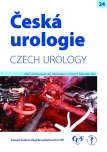Multi-resistant gram negative bacteria in urology
Authors:
Vanda Adamcová 1; Lucie Bartáková 1; Pavel Čermák 2; Roman Zachoval 1,3; Jan Hrbáček 1
Authors‘ workplace:
Urologická klinika 3. LF UK a Thomayerovy nemocnice, Praha
1; Oddělení klinické mikrobiologie, Thomayerova nemocnice, Praha
2; Urologická klinika 1. LF UK, Praha
3
Published in:
Ces Urol 2020; 24(1): 18-25
Category:
Review article
Overview
Gram-negative bacteria are the most com‑ mon pathogens causing urinary tract infections. The incidence of bacterial resistance is increasing worldwide. Prevention and treatment of infections caused by resistant bacteria are becoming a vast medical, social and financial problem. The biggest problems are health care-associated infections and infections related to invasive lines. Knowledge of resistance mechanisms and local epidemiological situation help with effective initiation of empirical antibiotic therapy
Keywords:
resistance – Urological infection – gram-negative bacteria – antibiotics
Sources
1. Rottier WC, Ammerlaan HSM, Bonten MJM. Effects of confounders and intermediates on the association of bacteraemia caused by extended‑spectrum β‑lactamase‑producing Enterobacteriaceae and patient outcome: a meta‑analysis. J Antimicrob Chemother. 2012; 67(6): 1311–1320. 2. Magyar A, Köves B, Nagy K, et al. Spectrum and antibiotic resistance of uropathogens between 2004 and 2015 in a tertiary care hospital in Hungary. J Med Microbiol. 2017; 66(6): 788–797. 3. Jawetz E, Brooks G, Melnick J, et al. Jawetz, Melnick, & Adelberg’s medical microbiology. 27th ed. New York: McGraw‑Hill Medical 2016: 231–236. 4. Page C. Integrated pharmacology. 3rd ed. [Edinburgh]: Elsevier Mosby; 2006: 113–118. 5. Munita JM, Arias CA. Mechanisms of Antibiotic Resistance. Microbiol Spectr [Internet]. duben 2016 [citován 31. říjen 2018]; 4(2). Dostupné z: https://www.ncbi.nlm.nih.gov/pmc/articles/PMC4888801/. 6. Varga M, Pantůček R, Růžičková V, Doškař J. Molecular characterization of a new efficiently trans‑ ducing bacteriophage identified in meticillin‑resistant Staphylococcus aureus. J Gen Virol. 2016; 97(1): 258–268. 7. European Centre for Disease Prevention and Control. Surveillance of antimicrobial resistance in Europe 2016. Annual Report of the European Antimicrobial Resistance Surveillance Network (EARS‑Net). Stockholm: ECDC; 2017. 8. Gohel K, Jojera A, Soni S, et al. Bacteriological Profile and Drug Resistance Patterns of Blood Culture Isolates in a Tertiary Care Nephrourology Teaching Institute. BioMed Res Int. 2014; 2014: 1–5. 9. Medina‑Polo J, Sopeña‑Sutil R, Benítez‑Sala R, et al. Prospective study analyzing risk factors and cha‑ racteristics of healthcare‑associated infections in a Urology ward. Investig Clin Urol. 2017; 58(1): 61. 10. Toner L, Papa N, Aliyu SH, et al. Extended‑spectrum beta‑lactamase‑producing Enterobacteriaceae in hospital urinary tract infections: incidence and antibiotic susceptibility profile over 9 years. World J Urol. 2016; 34(7): 1031–1037. 11. Ozgur BC, Ekıcı M, Yuceturk CN, Bayrak O. Bacterial colonization of double J stents and bacteriuria frequency. Kaohsiung J Med Sci. 2013; 29(12): 658–661. 12. Kehinde EO, Rotimi VO, Al‑Hunayan A, et al. Bacteriology of urinary tract infection associated with indwelling J ureteral stents. J Endourol. 2004; 18(9): 891–896. 13. Lojanapiwat B. Colonization of internal ureteral stent and bacteriuria. World J Urol. 2006; 24(6): 681–683.
14. Lara‑Isla A, Medina‑Polo J, Alonso‑Isa M, et al. Urinary Infections in Patients with Catheters in the Upper Urinary Tract: Microbiological Study. Urol Int. 2017; 98(4): 442–448. 15. van der Donk CFM, Beisser PS, Hoogkamp‑Korstanje JAA, et al. A 12 year (1998-2009) antibiotic resistance surveillance of Klebsiella pneumoniae collected from intensive care and urology patients in 14 Dutch hospitals. J Antimicrob Chemother. 2011; 66(4): 855–858. 16. Stapleton PJ, Lundon DJ, McWade R, et al. Antibiotic resistance patterns of Escherichia coli urinary isolates and comparison with antibiotic consumption data over 10 years, 2005–2014. Ir J Med Sci. 2017; 186(3): 733–741. 17. Hanuš M, Matoušková M, Králová V, et al. Imunostimulace polybakteriálním lyzátem (Urivac®) v pre‑ venci recidivujících infekcí dolních močových cest. Ces Urol 2015; 19(1): 33–43. 18. Cai T, Mazzoli S, Lanzafame P, et al. Asymptomatic Bacteriuria in Clinical Urological Practice: Preope‑ rative Control of Bacteriuria and Management of Recurrent UTI. Pathogens. 2016; 5(1): 4. 19. EAU Guidelines. Edn. presented at the EAU Annual Congress Copenhagen 2018. ISBN 978-94-92671-01-1. 20. Sousa R, Muñoz‑Mahamud E, Quayle J, et al. Is Asymptomatic Bacteriuria a Risk Factor for Prosthetic Joint Infection? Clin Infect Dis Off Publ Infect Dis Soc Am. 2014; 59(1): 41–47. 21. Concia E, Azzini AM. Aetiology and antibiotic resistance issues regarding urological procedures. J Chemother. 2014; 26(Suppl 1): S14–23. 22. Wullt B, Sundén F, Grabe M. Asymptomatic Bacteriuria is Harmless and Even Protective: Don’t Treat if You Don’t Have a Very Specific Reason. Eur Urol Focus. 2019; 5(1): 15–16. 23. Köves B. Asymptomatic Bacteriuria: To Treat or Not To Treat. Pro Treatment. Eur Urol Focus 2019; 5(1): 13–14. 24. Holý O, Matoušková I, Zatloukalová S, et al. Prevalence of strains of Staphylococcus epidermidis and other coagulase‑negative staphylococci with biofilm‑forming ability at a department of hemato‑oncology. Klin Mikrobiol Infekcni Lek. 2018; 24(3): 68–72.
Labels
Paediatric urologist Nephrology UrologyArticle was published in
Czech Urology

2020 Issue 1
Most read in this issue
- Our experience with MRI/TRUS software fusion for targeted prostate biopsies
- Multi-resistant gram negative bacteria in urology
- Hereditary renal cell carcinoma syndromes
- Case report of a gigantic recurrent angiomyolipoma in a horseshoe kidney
